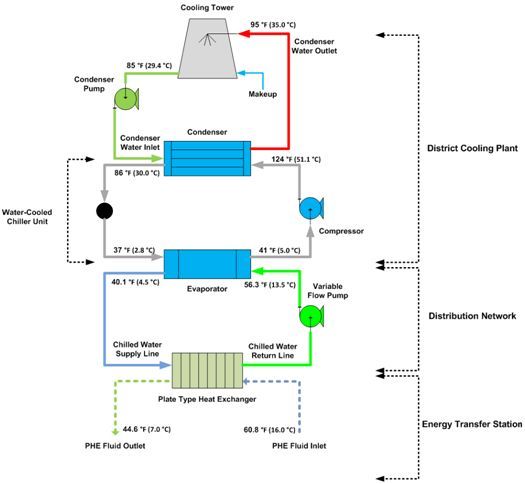VOLUME 6 NUMBER 2 (July to December 2013)

Philipp. Sci. Lett. 2013 6 (2) 182-197
available online: October 31, 2013
*Corresponding author
Email Address: gerardo_augusto@dlsu.ph
Submitted: March 24, 2013
Revised: July 28, 2013
Accepted: August 26, 2013
ARTICLE
Identification of design criteria fordistrict cooling distribution network
by Gerardo L. Augusto1,*, Alvin B. Culaba1, Raymond R. Tan 2
1Department of Mechanical Engineering, De La Salle University, Manila, Philippines2Department of Chemical Engineering, De La Salle University, Manila, Philippines
The hydraulic calculation and system simulation oftwo (2) district cooling distribution networkmodels with and without secondary lines arepresented in which the theoretical system pressuredrop, system flow rate and flow rate requirementsin each energy transfer station were determined considering atemperature difference set-point of 9℃. Variable primary flowof chilled water pumping arrangement was used to improveenergy usage and to eliminate the need for a separate distributionpump in the network.
Pipe sizing and friction factor identification were necessaryto determine the frictional coefficients of distribution networkcomponents. Implicit Colebrook-White equation was used todetermine the pipe friction factor. The method of least squaresand Cholesky decomposition method were also adopted toderive new set of pump characteristic curve considering thatpumps are modulated at its best efficiency points. The governingequations consisted of mass conservation and energy equationsin the form of pump characteristic curve and distributionnetwork characteristics. The system of nonlinear equations wassolved using multivariable Newton-Raphson method. Thelinearized equations revealed that coefficient matrices formedbetween the two networks were different from each other whichsuggested that different decomposition algorithms must be usedto ensure that solution vectors are properly determined.Distribution networks with and without secondary lines showedthat Jacobian matrix can be solved using singular-valuedecomposition and LU decomposition methods, respectively.The results of system simulation defined the coordinates ofsystem characteristic curve which indicated the best efficiencypoints during selected part load and full load conditions.
Pipe sizing and friction factor identification were necessaryto determine the frictional coefficients of distribution networkcomponents. Implicit Colebrook-White equation was used todetermine the pipe friction factor. The method of least squaresand Cholesky decomposition method were also adopted toderive new set of pump characteristic curve considering thatpumps are modulated at its best efficiency points. The governingequations consisted of mass conservation and energy equationsin the form of pump characteristic curve and distributionnetwork characteristics. The system of nonlinear equations wassolved using multivariable Newton-Raphson method. Thelinearized equations revealed that coefficient matrices formedbetween the two networks were different from each other whichsuggested that different decomposition algorithms must be usedto ensure that solution vectors are properly determined.Distribution networks with and without secondary lines showedthat Jacobian matrix can be solved using singular-valuedecomposition and LU decomposition methods, respectively.The results of system simulation defined the coordinates ofsystem characteristic curve which indicated the best efficiencypoints during selected part load and full load conditions.
© 2024 SciEnggJ
Philippine-American Academy of Science and Engineering